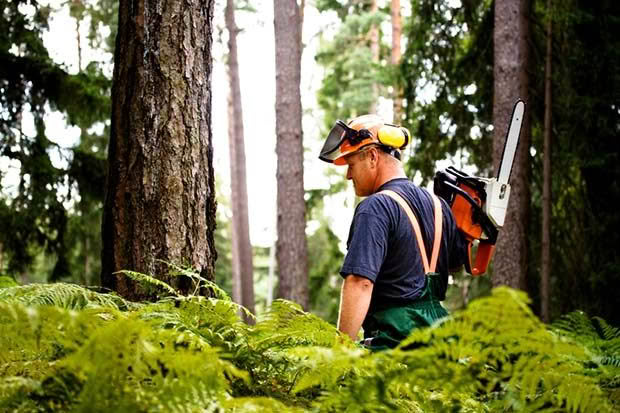Essential safety gear for DIY enthusiasts

Photos: Dreamstime
If you’re buying power equipment then you need to budget in the cost of safety gear.
Words: Nadene Hall
When using high speed equipment like brush cutters, chainsaws, lawnmowers or tractors, safety gear is vital. Eye and ear protection are probably the big two for most people, but other great options include all-in-one products (eye, ear and face protection), gloves, safety chaps and steel-capped boots.
EYE PROTECTION
$20-$50
It only takes a particle as small as a pinhead to cause serious damage to an eye, especially if it hits your eye at a fast speed. ACC say that most injuries to the eye result from people using the wrong eye protection that is either inadequate or inappropriate for the job they are doing.
To protect your eyes from objects that may be thrown towards your eyes, including rocks, soil or plant pieces you will need industrial-rate glasses or sunglasses or cushion-fitting ventilated plastic goggles if you are wearing prescription glasses.
If you are chipping, riveting, hammering, handling wire or cutting bricks you should be wearing goggles or eyewear marked HT or CT.
If you are using chemicals there are special shields and hoods that will be marked with a C to indicate they are appropriate.
For work involving medium velocity particles from jobs like grinding, machining metal or woodworking the appropriate goggles will be marked with an “I”.
To be extra safe choose goggles or safety glasses that have side shields to stop any particles flying into your eye around the edges of the glasses.
If you wear contact lenses, be aware that these will not protect your eye and often will actually make the situation worse if dust or chemical splashes enter the eyes. If you wear prescription glasses make sure your goggles or safety glasses comfortably fit over them.
EAR PROTECTION
$25-$100
How do you know if you need to be wearing ear protection? There is a simple rule you can use – if the noise is so loud that you have to shout to be understood by someone standing less than 1 metre away, you need hearing protection. Even using loud machinery for a few hours a month is doing irreparable damage to your hearing.
Good ear muffs and ear plugs will be marked with a grading between 1 and 5. The louder the noise, the higher the grade of ear protection you will require.
These are some of the minimum grades you need for different equipment:
Grade 2 – lawnmower, electric chainsaw, power tools, firearms, motorcycles, go-karts.
Grade 3 (noise up to 103dB) – tractors, petrol-driven chainsaws, motorized sprayers, scrubcutters and other motor-powered agricultural machinery
VISORS
$100-$120
These days you can get safety gear that suits a range of situations. A visor and earmuff assembly can be a great choice for a huge range of jobs. The visors flip up and down for ease of use and the ear muffs are usually highly graded.
SAFETY CHAPS
$190
Safety chaps are now so tough they can protect you from your chainsaw. Special retarding fibrous material is designed to stop the chain before it hits your flesh.

It’s important to wear the right safety gear when operating a chainsaw. Photo: Val_th | Dreamstime.com
WHY YOU NEED PROTECTION
YOUR EARS
When you are exposed to loud noises, delicate cells in the ear are damaged – work around loud noises for long enough and those cells will be destroyed. Your first indication will be trouble hearing common speech sounds like the letters t, s, p and f.
To put this into context, here are some common sounds on the farm and the time it takes to damage your hearing if you are not wearing some form of ear protection:
– chainsaw (petrol-driven) 30s
– motorcycle (off-road) 2 minutes
– tractor 4 minutes
– power tools 15 minutes
– lawnmower 1 hour
YOUR EYES
Most eye injuries are caused by four factors:
1. Being struck in the eyes by flying particles or objects, for example a nail flying out after a glancing hammer blow
2. Striking the eye against a moving or stationary object
3. Contact with splashes of liquid, molten metal, fumes or dust
4. Exposure to welding flashes and laser beams
To save an eye from permanent damage requires a speedy response. Lay the patient on the floor and poor cold water gently into their eye for 15 minutes. You may need assistance to hold their eye open especially in the case of a chemical splash. Use a clean container like a water bottle or a teapot. Get the person to medical help or call an ambulance if you are on your own.
If the patient is wearing contact lens don’t try and remove them before or during pouring water into the eye. You can do more damage and if the lens doesn’t wash out it will slide to the back of the eye where it can be removed later.
Don’t let a patient rub their eye or try and remove a foreign object that is embedded in it. Cover with gauze and get the person to hospital immediately.
DON’T FORGET YOUR LEGS:
A more recent safety innovation are cut resistant pants to protect your legs, especially made for those people using chainsaws. These come as pants or as chaps. They are made of small strands woven into a mat-like material then layered 6-8 times. If a chainsaw hits your leg, its teeth grab the outer cover of the pants and pull them into the drive sprocket of the chainsaw, jamming it and stopping it from rotating.
Research has found spilt oil and small cuts from previous accidents reduces the effectiveness of safety legwear.
Love this story? Subscribe now!
 This article first appeared in NZ Lifestyle Block Magazine.
This article first appeared in NZ Lifestyle Block Magazine.
